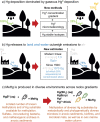Global change effects on biogeochemical mercury cycling
- PMID: 36988895
- PMCID: PMC10073400
- DOI: 10.1007/s13280-023-01855-y
Global change effects on biogeochemical mercury cycling
Abstract
Past and present anthropogenic mercury (Hg) release to ecosystems causes neurotoxicity and cardiovascular disease in humans with an estimated economic cost of $117 billion USD annually. Humans are primarily exposed to Hg via the consumption of contaminated freshwater and marine fish. The UNEP Minamata Convention on Hg aims to curb Hg release to the environment and is accompanied by global Hg monitoring efforts to track its success. The biogeochemical Hg cycle is a complex cascade of release, dispersal, transformation and bio-uptake processes that link Hg sources to Hg exposure. Global change interacts with the Hg cycle by impacting the physical, biogeochemical and ecological factors that control these processes. In this review we examine how global change such as biome shifts, deforestation, permafrost thaw or ocean stratification will alter Hg cycling and exposure. Based on past declines in Hg release and environmental levels, we expect that future policy impacts should be distinguishable from global change effects at the regional and global scales.
Keywords: Climate change; Environment; Exposure; Fish consumption; Minamata Convention; Toxicity.
© 2023. The Author(s).
Conflict of interest statement
The authors declare no conflicts of interest.
Figures






References
-
- AMAP . Arctic Climate Change Update 2021a: Key Trends and Impacts. Summary for Policy-Makers. Tromso: AMAP; 2021.
Publication types
MeSH terms
Substances
Grants and funding
LinkOut - more resources
Full Text Sources
Medical
Miscellaneous

